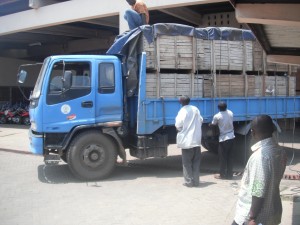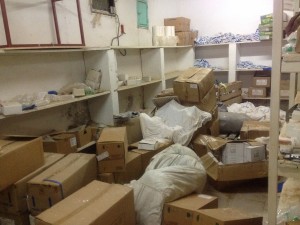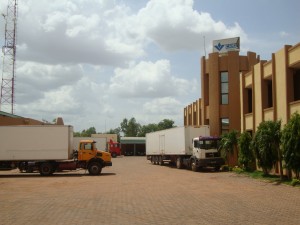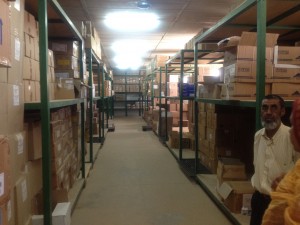Findings from supply chain rapid assessments improve odds for MDA success
January 30th, 2014
If there’s one thing that anyone who’s ever been involved in mass drug administration (MDA) for neglected tropical diseases (NTDs) knows, it’s that success depends heavily on the strength of the country’s NTD supply chain management (SCM) system.
We recently spoke with Paula Nersesian, Senior Public Health Specialist with END in Africa partner John Snow, Inc. (JSI), about how national NTD programs in Burkina Faso, Ghana, Niger, Sierra Leone and Togo, have used JSI’s NTD-oriented rapid assessment tool to evaluate and strengthen their SCM systems.
Q: We all know that MDA is the most effective way to eliminate neglected tropical diseases on a nation-wide level, but getting every at-risk person in the country to take preventive medicine seems like an impossible task. How did JSI help countries strengthen their SCM systems at the start of the END in Africa project, to help them increase their odds for success?
Paula Nersesian: You’re right that conducting a successful MDA campaign takes tremendous organizational skill at every level of the national health system. At the lowest level, this means mobilizing communities to ensure high participation rates; while at the highest level, managers must estimate and request the correct amount of medicines for the MDA from pharmaceutical companies’ drug donation programs well in advance of the campaigns. Then, national level managers have to get the medicine through customs and move it down the public health supply chain to peripheral health facilities, so community drug distributors can administer it to people in the community.
JSI proposed to do rapid assessments of the strengths and weaknesses of the national NTD supply chains in each of the five program countries at the start of the project. The idea was to identify potential obstacles in the drug supply chain and address them before starting the MDA campaigns. That way, MDAs would run smoothly.
Q: What is a rapid supply chain assessment, exactly? Would you tell us a little about how they’re done?
 PN: A rapid SC assessment basically involves using a standard interview guide–the rapid assessment tool–to conduct a series of meetings with individuals and groups of staff responsible for managing the NTD supply chain at the central, regional, district, and peripheral levels. Using the tool helps ensure that all of the key supply chain and logistics topics (see assessment topics box for a complete list) are addressed during these meetings.
PN: A rapid SC assessment basically involves using a standard interview guide–the rapid assessment tool–to conduct a series of meetings with individuals and groups of staff responsible for managing the NTD supply chain at the central, regional, district, and peripheral levels. Using the tool helps ensure that all of the key supply chain and logistics topics (see assessment topics box for a complete list) are addressed during these meetings.
In addition to meeting with key informants, the assessment team observes how staff at various levels manage their supplies. For example, they check to see if storage facilities comply with international standards for health products; they review forms and reports to ensure that essential service statistics and logistical information are documented so managers at each level can make effective decisions; and they examine the equipment used to dispose of MDA waste.
Q: As we all know, even the best recommendations are useless if no one acts on them. What did the END in Africa project do to ensure that the rapid SC assessment recommendations would actually be implemented?
PN: I guess our ‘secret,’ so to speak, is to make sure that the rapid assessment team gets input from all the key players, including central level Ministry of Health staff and representatives from each level of the health system, as well as staff from the supporting organizations. In our experience, this inclusive approach has two advantages. First, everyone who serves on the team learns how to conduct a rapid assessment. With their new skills, they can periodically assess operations in their work area. Second, participating in the assessment process teaches team members and participants about SCM best practices; it gives them a chance to ask questions about details that are unclear and sometimes they even have a chance to actually see how supply chain improvements can be implemented. For example, it’s possible to quickly reorganize a small storage facility and bring it up to standard during an assessment. As you can imagine, this helps them to really understand how those practices work and why they’re important.
After collecting all this data, the teams discuss the findings and propose process improvements. In each END in Africa country, the rapid SCM assessment team came up with a country-specific set of recommendations and a capacity building plan.
Q: So, now for the big question. Can you give us a general summary of the main findings common to all the national rapid SCM assessments?
PN: Since MDAs are typically held annually in most countries, the needs of national NTD supply systems differ somewhat from those of routine health services, which need to keep essential medicines in stock year-round. While some of the challenges NTD managers face are the same as those faced by systems with routine resupply systems, others are specific to NTD programs.
For example, national NTD supply chains, in particular, face some special challenges when it comes to customs clearance, reverse logistics, development of human resources, information systems and estimating medication needs. That’s not to say that routine resupply systems don’t face challenges in these areas too, because they do.
Q: That’s a long list! And while some of the items you mentioned make intuitive sense, others aren’t so apparent. For example, why would customs clearance be a challenge? And what’s being done now to address that challenge?
PN: To protect their citizens from substandard and counterfeit medicines, countries have strict procedures that must be followed precisely before drug shipments, also called consignments, can be cleared through customs. This includes the donations received from big pharmaceutical companies. The customs clearance process requires a mountain of documents since there are many people around the world who are working to get the donated drugs for MDAs into the country.
Each donation is generated a little bit differently, which means there are different players for each consignment. Each player, such as the national NTD program, Ministry of Finance, Drug Regulatory Authority, pharmaceutical donation program, END in Africa implementing partner, drug manufacturer, END in Africa, or World Health Organization, contribute required documents. Poor coordination with even one of these parties —the donor, procurer, supplier, NTD program and consignee—can result in serious delay of an MDA. It can also be extremely expensive for the national NTD program if clearance is delayed, because when consignments are held in customs storage facilities beyond a few days, costly penalties called demurrage fees begin to accumulate.
END in Africa and JSI staff work closely with our in-country partners through the entire process, beginning with placing orders for the medicine all the way through customs clearance. It’s an intensive process that benefits from shepherding. In other words, keeping an eye on all the pieces to be sure the process moves forward toward the destination, which is the first in-country warehousing site.
Luckily, pharmaceutical donation programs are collaborating to develop a common application and a unified approach to shipping that will consolidate the donated products from almost all of the participating donation programs into a single container. The details are still being sorted-out, and not all programs participate, but this is a step in the right direction.
Q: One of the main differences between national NTD and routine health programs is that NTD programs typically do MDA just during specific times of the year, while routine health programs distribute medication year-round. What happens to leftover NTD drugs after an MDA? Do programs just save them until next year?
PN: That’s a good question.Most countries seek to store donated NTD medicines at a regional or central storage location following an MDA since as you said, most of the left-over medicine is no longer needed that year once the MDA is over. Consolidating the meds at a higher level in the system facilitates better inventory management, in part because it makes it easier for the program to reallocate medicines among the districts, if needed, in the midst of an MDA.
Have you ever heard of first-to-expire, first-out? The idea is to use the older medicine first, before it expires. But if districts are holding left-over medicine in their storage facilities for long periods of time, they may forget it’s there. So when they get a new shipment, there is a risk that they’ll use the new stuff, rather than the older medicine. It’s just good inventory management practice to rotate stock responsibility, and consolidating left-over medicine helps make that happen.
The problem is that it’s not always so easy for district and lower levels of NTD programs to move medicine in reverse. This is especially difficult in countries where transportation resources are limited and where each level of the health system has to cover its own expenses. All too often rather than shoulder those added costs, local health staff will just stow left-over medicines in the local (often sub-standard) storage facility until the next MDA, often without regard to inventory management. When that happens, medicines may expire or become damaged, leaving national NTD programs with the difficult (and expensive!) task of responsibly collecting and disposing of the expired drugs.
That’s why national NTD programs and the projects that support them, like END in Africa, are so keen on making sure each district accurately forecasts its drug needs when planning for MDAs. The more accurate the forecasts, the less likely they’ll have to deal with the challenges of reverse logistics. One of the best ways to get good forecasts is make sure districts accurately report their stock-on-hand to the central level following an MDA, since last year’s actual drug usage numbers are important to consider when calculating next year’s needs.
Q: But since the central and district levels are so far away from each other, there’s really no easy way for NTD program managers to know whether or not all the post-MDA stock-on-hand is reported. How does END in Africa help make things easier for them in this regard?
PN: Our experience in END in Africa countries and elsewhere has been that when everyone in the SCM system knows that the information they share is actually used, logistics information tends to flow up and down the chain better. To help all the players in the supply chain understand their contribution to the system, we developed standard operating procedures (SOPs) for SCM as well as a training materials for staff at all levels.
We also provided training on supply chain management supervision to improve health workers’ ability to undertake supply management functions. Together, this helps ensure that staff at all levels truly understand and use the SOPs, so that accurate information is reported, received, and used at every level.
Q: How about information systems? Surely they also play an important role in getting everyone on the same page and improving standardization in the SCM system?
PN: Absolutely! END in Africa is helping countries adapt standard supply management forms for national NTD programs to help increase information capture, quality of data, and sharing up and down the supply chain. Plus, having standard forms will streamline the amount of paperwork that health workers have to do.
The SCM rapid assessment teams also recommended considering adopting mHealth strategies to improve reporting and information flow for NTD programs. Some staff use their own mobile phones to receive and make requests for medicines and submit reports, but that’s not a systematic mHealth strategy. We’d like to test a systematic approach.
Q: Earlier, you mentioned the importance of accurately forecasting drug donation needs in advance of MDAs. Did the SCM rapid assessment teams have any specific recommendations in regard to improving forecasting accuracy?
PN: They did, yes, but sometimes countries’ hands are tied in regard to forecasting methods. You see,some drug donation programs require countries to calculate forecasts using a set formula. Often, those donation requests are not cross-checked with all available information, such as community enumeration data, consumption data, and stock on hand. It’s frustrating because even though some NTD programs have tremendous amounts of available data that could be used to inform forecasting decisions, only some of that data is actually used. Not surprisingly, this leads to imprecise forecasts and either over- or under-estimations of need.
So, the SCM rapid assessment teams recommended using all available data to more accurately estimate needs at the national and lower levels, and to include buffer stock in the calculation to avoid stock-outs.
Q: Thanks very much for talking with us, Paula. It’s great to hear about all the improvements in national NTD SCM systems that have come out of the rapid assessments. Before you go, would you give us a clue as to what’s next on the agenda for improving SCM for national NTD programs?
PN: Right now, the countries are reviewing the SOPs; and END in Africa is working with them to customize the SOPs, as needed, to address any unique national circumstances. The END in Africa team is also helping countries include key supply chain concepts from the SOPs in their existing NTD program training materials. I’ll keep you posted on how things turn out.
Note: See JSI’s Getting Products to People to learn more about the challenges of end-to-end supply chain integration in the context of public health supply chains in low-resource settings.








